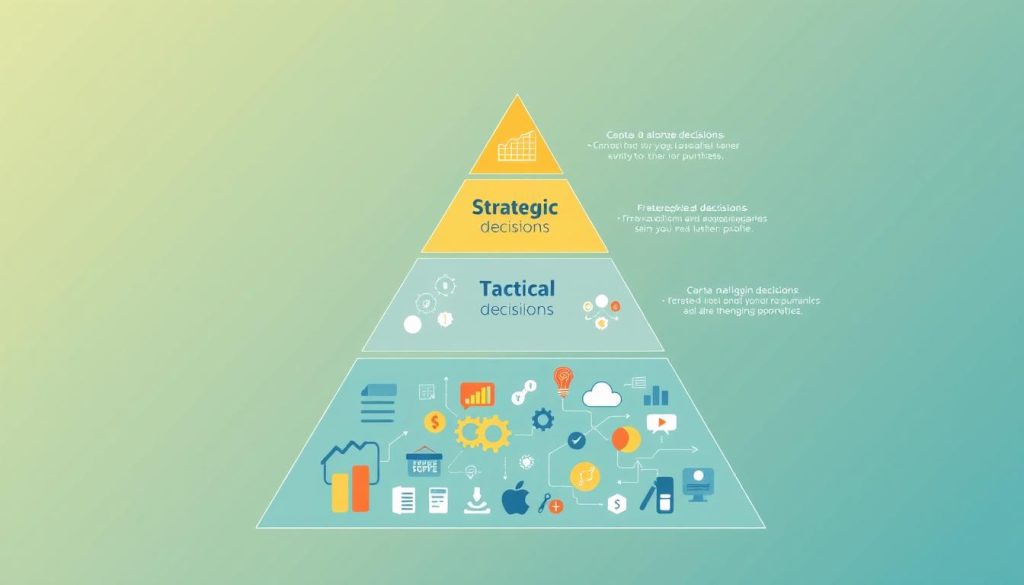B2B transactions involve complex buying decisions that differ from consumer purchases. These decisions include multiple decision-makers, approval processes, and strategic considerations. Understanding these aspects helps marketers and sales professionals navigate the B2B landscape effectively.
Organizations can align their strategies by grasping organizational buying behavior. This knowledge enables them to tailor their approach to various decision-making levels. It also helps in addressing the unique needs of business clients.
Key Takeaways
- Businesses engage in a multi-layered decision-making process for purchases, unlike individual consumers.
- Factors such as risk assessment, financial implications, and strategic planning play a significant role in B2B purchasing decisions.
- The complexity of the buying center, which encompasses various stakeholders, shapes the decision-making hierarchy.
- Navigating different purchase levels, from new buy to modified rebuy and straight rebuy, requires tailored strategies.
- Technological advancements, including AI and automation, are transforming the modern business purchasing landscape.
Understanding the Fundamentals of B2B Purchasing Decisions
B2B purchasing decisions are vital for organizational success. They’re shaped by business buying behavior, strategic planning, and market conditions. These factors interact to influence how companies make their buying choices.
Key Components of Business Buying Behavior
B2B buying behavior involves several key elements. These include the decision-making unit, the buying process, and supplier evaluation criteria. Grasping these components is crucial for businesses navigating B2B purchasing decisions.
The Role of Strategic Planning in Purchase Decisions
Strategic planning is essential in B2B purchasing decisions. Companies must consider long-term goals, budget limits, and risk tolerance when making choices. This approach aligns procurement with broader business objectives.
It ensures that each purchase supports overall growth and competitiveness. By planning strategically, organizations can make more effective purchasing decisions.
Impact of Market Conditions on Business Purchases
Market conditions heavily influence B2B purchasing. Economic trends, industry regulations, and competitive dynamics all play a role. Businesses must monitor these factors closely.
Adapting purchasing strategies to changing conditions is crucial. This ensures companies make informed decisions that address their evolving needs and challenges.

“Understanding the fundamentals of B2B purchasing decisions is crucial for businesses seeking to gain a competitive edge in the marketplace.”
The Strategic Importance of the Buying Center
The buying center is vital in B2B purchasing decisions. It’s a group of people who evaluate and approve purchases for an organization. Understanding this group is key for businesses navigating organizational buying behavior.
The buying center has several important roles. Each role has unique duties and viewpoints. These roles shape the decision-making process.
- Users: The individuals who will directly use or consume the purchased product or service.
- Influencers: Those who provide input and recommendations on the purchase decision.
- Deciders: The individuals who have the authority to ultimately approve or reject the purchase.
- Buyers: The professionals responsible for negotiating and finalizing the purchase agreement.
- Gatekeepers: Those who control the flow of information and access to the buying center.
The buying center shapes buying decision roles and organizational buying behavior. Understanding each role’s needs helps businesses develop effective strategies. These strategies can influence purchase decisions positively.
| Role | Responsibilities | Key Considerations |
|---|---|---|
| Users | Provide input on product/service requirements and usage | Ensure the purchased solution meets their needs and improves their workflow |
| Influencers | Offer recommendations and insights based on their expertise | Address their concerns and align the purchase with organizational goals |
| Deciders | Make the final decision on the purchase | Demonstrate the strategic value and return on investment (ROI) of the purchase |
| Buyers | Negotiate terms and finalize the purchase agreement | Provide competitive pricing, flexible payment options, and a streamlined procurement process |
| Gatekeepers | Control the flow of information and access to the buying center | Build strong relationships and establish trust to gain their support |
Businesses can boost their chances of success by aligning with the buying center’s needs. This approach can help secure valuable B2B deals. It’s crucial to tailor strategies to each role in the buying center.
“Understanding the buying center is essential for any company seeking to win in the B2B market. Tailoring your approach to the specific roles and dynamics within the buying center can mean the difference between success and failure.”

What Are the Levels of Buying Decisions for Business Purchases?
Business purchases involve different levels of decision-making. Three distinct tiers exist in B2B purchasing: new buy, modified rebuy, and straight rebuy. Each level has unique characteristics and challenges for organizations.
Understanding Decision-Making Hierarchy
New buy decisions involve acquiring unfamiliar products or services. These high-stakes choices require extensive research and strategic planning. Organizations must carefully assess risks to ensure the best outcome.
Modified rebuy decisions consider changes to existing purchases. This might include switching suppliers or altering product specifications. These choices balance the need for change with familiar relationships and processes.
Straight rebuy represents routine purchase decisions. Organizations repeatedly acquire the same product or service from established suppliers. Well-defined procurement policies typically govern these purchases.
Risk Assessment in Different Purchase Levels
Each purchase decision level carries varying degrees of risk. New buys have the highest uncertainty as organizations explore unfamiliar territory. Modified rebuys present moderate risk, potentially disrupting established workflows and supplier relationships.
Straight rebuys often involve the lowest risk. Organizations leverage their experience and familiarity with these purchases. This leads to more predictable outcomes and fewer surprises.
Financial Implications Across Decision Levels
The financial implications of business purchases differ across decision-making levels. New buys typically require significant investment in research, evaluation, and implementation. Modified rebuys may involve a mix of new and existing costs.
Straight rebuys generally have the most predictable financial impact. Organizations can use their experience and established processes to manage costs effectively.

Understanding levels of buying decisions for business purchases is crucial. It helps organizations navigate complex B2B purchasing decisions. By recognizing the decision-making hierarchy, businesses can make informed choices aligned with their strategic goals.
New Buy Decisions: Navigating Uncharted Territory
New buy decisions in B2B purchasing can be tricky for businesses. These first-time purchases need thorough research, careful evaluation, and smart decision-making.
The business buying process for new purchases involves many factors. Companies must understand market trends, competitor offerings, and their own unique needs. They should be ready to face challenges and seize opportunities in these uncharted decisions.
Strategies for Navigating New Buy Decisions
- Comprehensive Market Research: Gather in-depth information about the industry, competitors, and customer preferences to make informed decisions.
- Thorough Needs Assessment: Carefully analyze the organization’s specific requirements and pain points to identify the most suitable solutions.
- Collaborative Decision-Making: Involve key stakeholders throughout the decision-making process to ensure alignment and buy-in.
- Risk Mitigation: Proactively identify and address potential risks, ensuring the new purchase aligns with the organization’s risk tolerance.
- Post-Purchase Evaluation: Continuously monitor and evaluate the performance of the new purchase, making adjustments as needed.
Using these strategies, businesses can confidently navigate new buy decisions. This approach can lead to long-term success and growth for the company.

“The secret to successful new buy decisions lies in a strategic, well-informed approach that anticipates and addresses the unique challenges of first-time purchases.”
| Key Considerations | Importance |
|---|---|
| Market Research | Crucial for understanding industry trends, competitor offerings, and customer needs |
| Needs Assessment | Vital for identifying the organization’s specific requirements and pain points |
| Collaborative Decision-Making | Essential for aligning stakeholders and ensuring buy-in |
| Risk Mitigation | Crucial for managing potential risks and ensuring the purchase aligns with the organization’s risk tolerance |
| Post-Purchase Evaluation | Vital for continuously monitoring and adjusting the new purchase to drive long-term success |
Modified Rebuy: Balancing Change and Familiarity
Modified rebuy situations are vital in B2B purchasing decisions. They occur when organizations need to change existing purchases. This process balances familiar suppliers with new options.
Evaluating Existing Supplier Relationships
Companies must carefully assess their current supplier relationships in modified rebuy decisions. They evaluate performance, reliability, and overall satisfaction with the provider. Product quality, delivery times, and customer service are key factors.
Analyzing Cost-Benefit in Modified Purchases
Modifying purchases often has financial implications. Organizations must analyze the cost-benefit ratio for any changes. This may involve comparing prices and negotiating better terms.
Exploring alternative products or services that offer enhanced value is also important. The goal is to ensure changes result in tangible improvements.
Implementation Strategies for Modified Rebuys
- Develop a clear implementation plan: Outline the steps, timelines, and responsibilities for a seamless transition to a modified rebuy.
- Communicate extensively with stakeholders: Keep all parties informed and aligned throughout the decision-making and implementation process.
- Monitor and evaluate the new arrangement: Continuously assess the performance of the modified rebuy to ensure it meets the organization’s needs and expectations.
Organizations can navigate modified rebuy decisions by evaluating suppliers and analyzing costs. Implementing effective strategies helps balance familiar partnerships with new options. This approach leads to more informed and strategic modified rebuy decisions.
| Factors to Consider | Existing Supplier | New Supplier |
|---|---|---|
| Product Quality | 4.8/5 | 4.6/5 |
| Delivery Times | 3 days | 5 days |
| Customer Service | Excellent | Good |
| Cost | $50,000 | $45,000 |
“In a modified rebuy, balancing the familiar with the new is the key to unlocking greater value and optimizing B2B purchasing decisions.”
Straight Rebuy: Streamlining Routine Purchases
Straight rebuy decisions are a key part of B2B purchasing. These routine buys happen often, with little change from past transactions. They’re the most efficient type of organizational buying behavior.
Straight rebuy decisions have several key features. They involve familiar products or services. Buyers have established relationships with suppliers. There’s little need for extensive evaluation or negotiation.
These decisions offer many benefits to organizations. They save time and resources by simplifying the buying process. Trust and efficiency grow through established supplier relationships.
But straight rebuy decisions aren’t risk-free. Companies must stay alert to avoid missing opportunities. Over-reliance can make them vulnerable to market changes or supplier issues.
| Advantages of Straight Rebuy Decisions | Potential Risks of Straight Rebuy Decisions |
|---|---|
|
|
Organizations should regularly review their straight rebuy decisions. This ensures they align with strategic goals and market conditions. Careful management of B2B purchasing can optimize procurement and maintain competitiveness.
The Role of Technology in Modern Business Purchasing
Technology is reshaping B2B purchasing decisions and the business buying process. Digital transformation has revolutionized procurement, leading to more efficient and data-driven decision-making. This shift has streamlined how organizations approach their purchasing choices.
Digital Transformation of Procurement
Procurement has undergone a significant digital shift, using advanced technologies to enhance B2B purchasing. Online supplier portals and automated approval workflows have improved efficiency. Real-time data analytics and cloud-based platforms have optimized organizational buying behavior.
AI and Automation in Purchase Decisions
AI and automation are increasingly influencing B2B purchasing decisions. Advanced algorithms analyze data, identify trends, and provide valuable insights for decision-makers. Automation streamlines routine tasks and reduces human error risks.
This technology allows procurement teams to focus on strategic initiatives. It improves the overall efficiency of the purchasing process.
Integration of Purchase Management Systems
Integrating purchase management systems is crucial in modern business buying. ERP and SRM platforms enable real-time data sharing and improved visibility. These systems enhance collaboration across organizations, leading to more effective B2B purchasing decisions.
Technology’s role in business purchasing continues to grow. Embracing digital transformation and AI helps organizations optimize their B2B purchasing decisions. This approach streamlines the buying process and enhances overall organizational buying behavior.
Risk Management in Business Purchase Decisions
Effective risk management is vital in B2B purchasing. It helps organizations navigate complex business buying decisions. Understanding and addressing procurement risks can boost a company’s purchasing success.
The first step is identifying various risks, including financial and operational. Evaluating their potential impact helps businesses prioritize efforts. Strategies like supplier due diligence and contingency plans can mitigate unforeseen events.
Incorporating risk management into strategic planning is crucial. It prepares organizations for market changes and regulatory shifts. This approach helps companies make informed choices aligned with their goals.
A risk-aware culture leads to better decision-making. It minimizes potential costly disruptions. Companies can then focus on achieving their business objectives more effectively.




